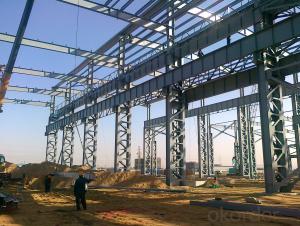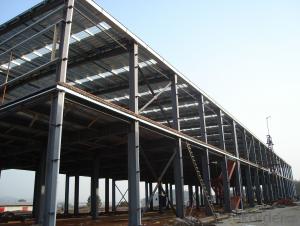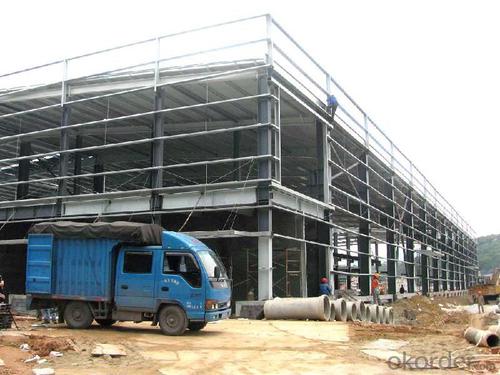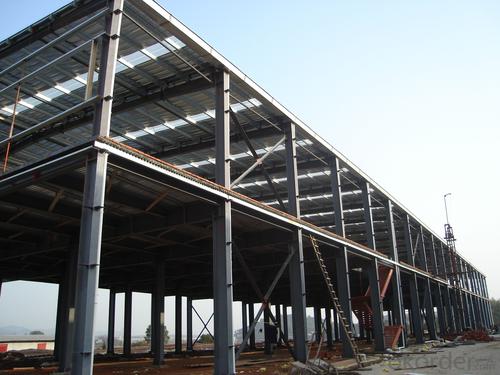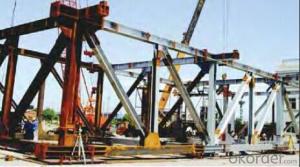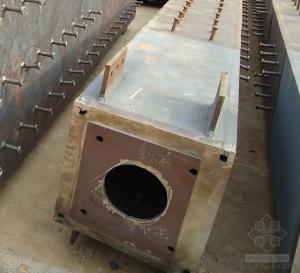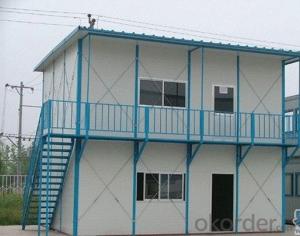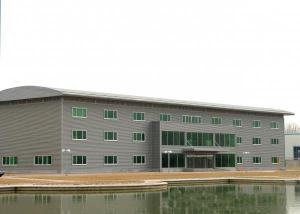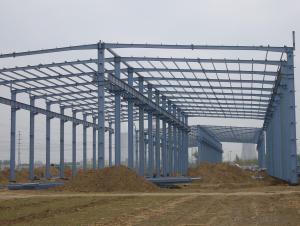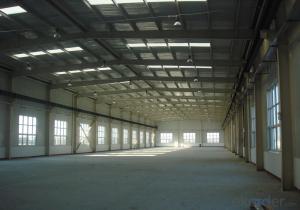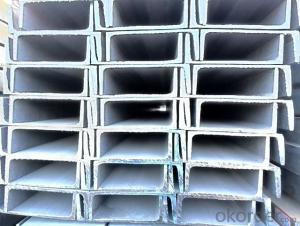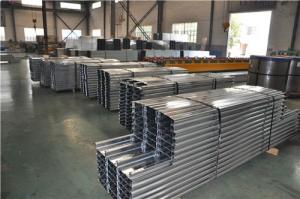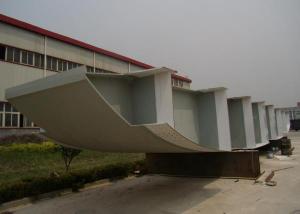Ware House Steel Structure Building
- Loading Port:
- China Main Port
- Payment Terms:
- TT OR LC
- Min Order Qty:
- -
- Supply Capability:
- -
OKorder Service Pledge
OKorder Financial Service
You Might Also Like
Steel Structure Building
1.the connection method of steel structure:
welding connection or bolt connection
2.Steel structure design common norms are as follows:
"Steel Design Code" (GB50017-2003)
"Cold-formed steel structure technical specifications" (GB50018-2002)
"Construction Quality Acceptance of Steel" (GB50205-2001)
"Technical Specification for welded steel structure" (JGJ81-2002, J218-2002)
"Technical Specification for Steel Structures of Tall Buildings" (JGJ99-98)
3.The characteristics of steel
Light weight steel structure
Higher reliability of steel work
Steel anti-vibration (earthquake), impact and good
Steel structure for a higher degree of industrialization
Steel can be assembled quickly and accurately
Large steel interior space
Likely to cause sealing structure
Steel corrosive
Poor fire-resistant steel
Recyclable steel
Steel shorter duration
4.Commonly used steel grades and performance of steel
Carbon structural steel: Q195, Q215, Q235, Q255, Q275, Q345,etc.
High-strength low-alloy structural steel
Quality carbon structural steel and alloy structural steel
Special purpose steel
5.Market:
Products have been all over the country more than 20 provinces, municipalities and autonomous regions, and have been exported to Europe, North America, the Middle East, Africa, Asia and other countries and regions, the widespread use
- Q: What are the different types of steel cladding and facade systems used in buildings?
- There are several different types of steel cladding and facade systems that are commonly used in buildings. These systems are chosen based on factors such as the building's design, aesthetics, durability, and budget. Here are some of the most common types: 1. Steel Panels: Steel panels are one of the most popular choices for cladding and facade systems. They are available in various shapes, sizes, and finishes, allowing for a wide range of design possibilities. Steel panels are durable, low maintenance, and can be easily installed. 2. Steel Mesh: Steel mesh cladding is a versatile system that can be used to create unique and visually appealing facades. It consists of a grid of steel wires or bars that are woven or welded together. Steel mesh offers transparency, allowing for natural light and ventilation while providing a modern and industrial aesthetic. 3. Corrugated Steel Sheets: Corrugated steel sheets are commonly used for cladding and facade systems in industrial and agricultural buildings. They are lightweight, cost-effective, and provide excellent strength and durability. Corrugated steel sheets are available in different profiles and can be coated with various finishes for enhanced aesthetics. 4. Perforated Steel Panels: Perforated steel panels are widely used for both cladding and facade systems. They are designed with small holes or patterns that allow for ventilation and light transmission while maintaining privacy and security. Perforated steel panels can be customized to create unique and intricate designs. 5. Stainless Steel Cladding: Stainless steel cladding offers a high-end and sleek appearance to buildings. It is highly durable, corrosion-resistant, and requires minimal maintenance. Stainless steel cladding is often used in commercial and high-end residential buildings to achieve a modern and luxurious aesthetic. 6. Standing Seam Systems: Standing seam systems are a popular choice for roof and wall cladding. They consist of interlocking metal panels that create a continuous seam, providing excellent weather resistance and durability. Standing seam systems can be made from various metals, including steel, aluminum, and copper, offering a wide range of design options. 7. Composite Panels: Composite panels are a combination of steel and other materials, such as aluminum or fiberglass, bonded together to create a lightweight and highly insulating cladding system. These panels offer excellent thermal performance, fire resistance, and are available in a variety of finishes and colors. These are just a few examples of the different types of steel cladding and facade systems used in buildings. Each system has its own advantages and can be chosen based on the specific requirements of the project.
- Q: How are steel structures inspected for quality control?
- Steel structures are inspected for quality control through various methods. Firstly, visual inspections are conducted to check for any visible defects, such as cracks, weld discontinuities, or surface imperfections. Additionally, non-destructive testing techniques like ultrasonic testing, magnetic particle inspection, or radiographic testing are used to detect hidden defects within the steel components. This ensures that the structure meets the required standards and specifications for strength, durability, and safety.
- Q: How are steel structures used in data centers and server farms?
- Steel structures are extensively used in data centers and server farms due to their strength, durability, and ability to support heavy equipment. They provide the necessary framework for housing servers, networking equipment, and other critical components. Steel structures also enable efficient cable management and facilitate the installation of cooling systems, ensuring optimal performance and reliability for data centers and server farms.
- Q: How do steel structures provide resistance against seismic pounding?
- Steel structures provide resistance against seismic pounding through several mechanisms. Firstly, steel structures are designed with flexible connections between different components. These flexible connections allow for slight movement and flexibility during an earthquake, which helps to absorb and dissipate the seismic energy. This prevents the transfer of excessive forces between adjacent structural elements, reducing the potential for pounding. Additionally, steel structures are often equipped with dampers and energy dissipation devices. These devices are strategically placed within the structure to absorb and dissipate seismic energy. They act as shock absorbers, reducing the overall forces transmitted to the structure and minimizing the potential for pounding. Moreover, steel structures are designed with appropriate clearances and gaps between adjacent elements. These clearances provide the necessary space for relative movement between components during an earthquake, further preventing direct contact and potential pounding. Furthermore, the use of base isolation techniques is common in steel structures. Base isolation involves placing the structure on flexible bearings or isolators, which significantly reduce the transmission of seismic forces to the building. By isolating the structure from the ground motion, the potential for pounding is greatly reduced. Lastly, steel structures are designed to be ductile, meaning they have the ability to undergo large deformations without failure. This ductility allows the structure to absorb and redistribute the seismic energy, preventing concentrated forces that could lead to pounding. Overall, the combination of flexible connections, energy dissipation devices, appropriate clearances, base isolation, and ductility in steel structures contributes to their resistance against seismic pounding. These design features work together to minimize the potential for structural damage and ensure the safety of the occupants during an earthquake.
- Q: How are steel structures used in mining and mineral processing?
- Steel structures are widely used in mining and mineral processing due to their durability, strength, and versatility. These structures are employed in various aspects of mining operations, from the exploration and extraction of minerals to their transportation and processing. In the exploration phase, steel structures are used to create mine shafts and tunnels. These structures offer excellent stability and support, ensuring the safety of miners and facilitating the efficient extraction of minerals from underground. Additionally, steel structures are utilized in the construction of drilling rigs and equipment, enabling the exploration of new mineral deposits. During the extraction phase, steel structures are essential in the form of mining equipment, such as crushers, conveyors, and screens. These structures provide a sturdy framework for the machinery, allowing for the efficient processing of ores and minerals. Steel is also used to construct storage facilities, such as silos and bins, which are responsible for storing the extracted minerals before further processing. Steel structures are crucial in the transportation of minerals within mining sites. Conveyor systems, often made of steel, are used to transport bulk materials, such as coal, iron ore, and copper, from one location to another. These structures are designed to withstand heavy loads and harsh conditions, ensuring the smooth flow of materials in the mining and mineral processing operations. In the mineral processing phase, steel structures are utilized extensively. Processing plants, such as smelters and refineries, are typically constructed using steel due to its fire resistance and ability to withstand high temperatures. Steel tanks and vessels are used to store and process chemicals, acids, and other substances involved in mineral processing. Furthermore, steel structures are employed in the construction of support buildings, offices, and maintenance facilities within mining sites. These structures provide a safe and functional environment for the mining workforce, enabling efficient operations and ensuring the well-being of employees. Overall, steel structures play a crucial role in mining and mineral processing by providing the necessary support, stability, and durability required for various operations. Their versatility allows for the construction of a wide range of structures, from mine shafts to processing plants, ensuring the smooth and efficient extraction and processing of minerals.
- Q: How are steel structures used in the construction of historical buildings?
- Steel structures are commonly used in the construction of historical buildings to reinforce and strengthen the existing framework. They are often employed to replace deteriorated or damaged components, such as columns or beams, providing structural support and stability without compromising the building's historical integrity. Additionally, steel structures can be used to create new additions or extensions to historic buildings, seamlessly blending modern construction techniques with traditional architectural styles.
- Q: What are the considerations for steel structure design in coastal areas?
- To ensure the longevity and durability of steel structures in coastal areas, it is necessary to take several factors into account: 1. To prevent rust and degradation, it is important to use corrosion-resistant materials and protective coatings in steel structures exposed to saltwater, humidity, and atmospheric conditions. 2. The choice of steel alloys is crucial in coastal areas. Stainless steel or galvanized steel are commonly used due to their high resistance to corrosion, providing additional protection against the effects of saltwater and moisture. 3. Structural design should consider the impact of strong winds, waves, and salt spray. Adequate structural systems, such as bracing and reinforcements, must be implemented to withstand these forces and prevent damage or failure. 4. Foundation design can be challenging in coastal areas with sandy or loose soil. Proper site investigation and soil analysis should be conducted to determine the appropriate foundation design, which may include deep foundations or pile systems to ensure stability and prevent soil erosion. 5. Regular maintenance and inspection are essential for steel structures in coastal areas. Routine inspections should be carried out to identify signs of corrosion or damage, and prompt repairs or maintenance should be conducted to prevent further deterioration. 6. Environmental impact should also be considered in the design of steel structures in coastal areas. The use of sustainable materials, such as recycled steel or low-carbon steel, can reduce the carbon footprint. Additionally, measures should be taken to protect the surrounding ecosystem and habitats during construction and operation. In conclusion, designing steel structures in coastal areas requires careful consideration of corrosion resistance, material selection, structural design, foundation design, maintenance, and environmental impact. By addressing these factors, a steel structure can be constructed to withstand the challenging coastal environment and ensure long-term performance and safety.
- Q: What are the limitations of using steel structures in construction?
- There are a few limitations to using steel structures in construction. First, steel is susceptible to rust and corrosion, especially in humid or coastal environments. This requires regular maintenance and protective coatings to prevent deterioration. Second, steel has a high thermal conductivity, making it prone to expansion and contraction with temperature changes. This can lead to issues such as cracking or warping if not properly addressed. Lastly, steel structures can be more expensive compared to other materials, especially for small-scale or residential projects. However, despite these limitations, steel remains a popular choice due to its strength, versatility, and ability to support large-scale structures.
- Q: How are steel structures designed to be resistant to vibration and oscillation?
- Steel structures are designed to be resistant to vibration and oscillation through various design considerations and techniques. First and foremost, the overall structural design is done in such a way as to ensure stability and rigidity. This involves carefully selecting the appropriate steel members and configurations to provide adequate strength and stiffness. One common technique used is the inclusion of bracing systems. Braces are typically diagonal members placed within the structure to help distribute external loads and reduce the effects of vibration. The braces are strategically placed to create a network of interconnected elements that can effectively absorb and dissipate the energy generated by vibrations. Furthermore, damping systems can be incorporated into the design to help reduce the amplitude of oscillations. These systems include devices such as tuned mass dampers or viscous dampers. Tuned mass dampers are effectively large weights that are tuned to the frequency of the structure's vibrations, while viscous dampers use fluid-based mechanisms to dissipate energy and reduce oscillations. Additionally, the choice of materials and construction techniques can also contribute to the overall resistance to vibration and oscillation. For example, using steel with higher tensile strength can help minimize deformation and reduce the effects of vibrations. Similarly, welding techniques that ensure proper joints and connections play a crucial role in maintaining structural integrity and minimizing the risk of oscillations. Finally, it is important to consider the dynamic loads that the structure may be subjected to during its lifetime. This includes factors such as wind loads, seismic activity, and even human-induced vibrations. By analyzing and accounting for these dynamic loads during the design phase, engineers can ensure that the structure is sufficiently robust and resistant to vibrations and oscillations. In conclusion, steel structures are designed to be resistant to vibration and oscillation through a combination of careful structural design, the inclusion of bracing systems, the use of damping systems, the choice of materials, and the consideration of dynamic loads. These measures help ensure the stability, rigidity, and overall safety of the structure, even in the face of external vibrations and oscillations.
- Q: What are the requirements for designing steel agricultural buildings?
- The requirements for designing steel agricultural buildings typically include factors such as durability, strength, corrosion resistance, weather resistance, proper ventilation, sufficient space for livestock and equipment, appropriate lighting, and compliance with local building codes and regulations. Additionally, considerations for efficient use of space, flexibility for future expansion, and cost-effectiveness are also important factors in designing steel agricultural buildings.
Send your message to us
Ware House Steel Structure Building
- Loading Port:
- China Main Port
- Payment Terms:
- TT OR LC
- Min Order Qty:
- -
- Supply Capability:
- -
OKorder Service Pledge
OKorder Financial Service
Similar products
Hot products
Hot Searches
Related keywords

